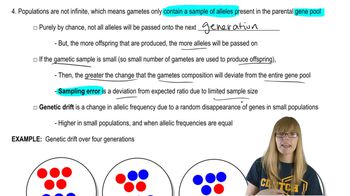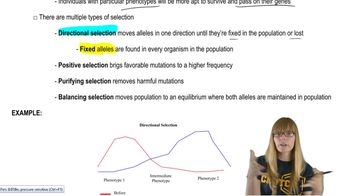Table of contents
- 1. Introduction to Genetics51m
- 2. Mendel's Laws of Inheritance3h 37m
- 3. Extensions to Mendelian Inheritance2h 41m
- 4. Genetic Mapping and Linkage2h 28m
- 5. Genetics of Bacteria and Viruses1h 21m
- 6. Chromosomal Variation1h 48m
- 7. DNA and Chromosome Structure56m
- 8. DNA Replication1h 10m
- 9. Mitosis and Meiosis1h 34m
- 10. Transcription1h 0m
- 11. Translation58m
- 12. Gene Regulation in Prokaryotes1h 19m
- 13. Gene Regulation in Eukaryotes44m
- 14. Genetic Control of Development44m
- 15. Genomes and Genomics1h 50m
- 16. Transposable Elements47m
- 17. Mutation, Repair, and Recombination1h 6m
- 18. Molecular Genetic Tools19m
- 19. Cancer Genetics29m
- 20. Quantitative Genetics1h 26m
- 21. Population Genetics50m
- 22. Evolutionary Genetics29m
21. Population Genetics
Allelic Frequency Changes
Problem 1b
Textbook Question
Compare and contrast the terms in each of the following pairs: founder effect and genetic bottleneck
 Verified step by step guidance
Verified step by step guidance1
Identify that both the founder effect and genetic bottleneck are mechanisms of genetic drift, which is a change in allele frequencies due to random sampling in small populations.
Understand that the founder effect occurs when a small group of individuals becomes isolated from a larger population, leading to a new population with a different allele frequency than the original population.
Recognize that a genetic bottleneck happens when a large population undergoes a significant reduction in size due to an event (e.g., natural disaster), resulting in a loss of genetic diversity and a change in allele frequencies.
Compare the two: the founder effect involves the establishment of a new population by a small number of individuals, while a genetic bottleneck involves a reduction in the size of an existing population.
Contrast the outcomes: both can lead to reduced genetic variation, but the founder effect often results in a new population with unique genetic traits, whereas a bottleneck can lead to a population with reduced genetic diversity and potential inbreeding.
Recommended similar problem, with video answer:
 Verified Solution
Verified SolutionThis video solution was recommended by our tutors as helpful for the problem above
Video duration:
3mPlay a video:
Was this helpful?
Key Concepts
Here are the essential concepts you must grasp in order to answer the question correctly.
Founder Effect
The founder effect occurs when a small group of individuals establishes a new population, leading to a reduced genetic diversity compared to the original population. This can result in certain alleles becoming more prevalent or even fixed in the new population, which may not reflect the genetic makeup of the larger source population. An example is the Amish communities in the United States, where certain genetic traits are more common due to the limited number of founders.
Recommended video:
Guided course

Maternal Effect
Genetic Bottleneck
A genetic bottleneck is a sharp reduction in the size of a population due to environmental events or human activities, which drastically decreases genetic diversity. This loss of genetic variation can lead to inbreeding and an increased risk of extinction. An example is the Northern elephant seal, which was hunted to near extinction, resulting in a population that is genetically less diverse than its ancestors.
Recommended video:
Guided course

Descriptive Genetics
Genetic Drift
Genetic drift is a mechanism of evolution that refers to random changes in allele frequencies within a population, particularly in small populations. Both the founder effect and genetic bottleneck are examples of genetic drift, as they illustrate how chance events can significantly influence genetic variation. Over time, genetic drift can lead to the fixation or loss of alleles, impacting the population's evolutionary trajectory.
Recommended video:
Guided course

Genetic Drift

 5:58m
5:58mWatch next
Master Natural Selection with a bite sized video explanation from Kylia Goodner
Start learning



